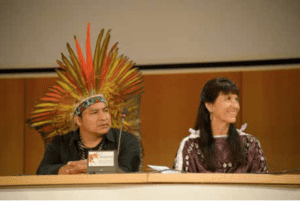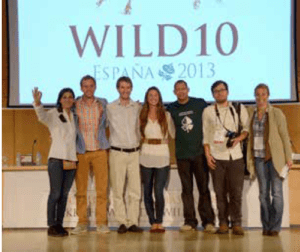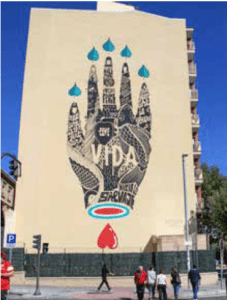Soul of the Wilderness
August 2014 | Volume 20, Number 2
by VANCE G. MARTIN AND MELANIE HILL
Background
The World Wilderness Congress (WWC) was initiated in South Africa in 1977 and has since become a global process occurring approximately every three or four years in a different region. It is the world’s longest-running, international public environmental program. A project of The WILD Foundation and its colleagues in The Wilderness Network (Wilderness Foundations in the UK and Africa), with many hundreds of collaborators and partners, the WWC focuses on the interface between human society and wild nature – defined broadly as wildlands and seas, including designated wilderness. Intensive collaboration over two years leads to an actual gathering (Congress of Delegates) and involves science, policy, communications, the arts, and humanities, boasting delegates and leaders from governments, the private sector, communities, civil society, and the public. It produces positive and practical solutions that protect wild nature and address the needs of human communities, and it helps inspire the passion and commitment required to create a new relationship between nature and people.
WILD10
The WILD10 collaborative process was endorsed by Spain’s Ministry of Food, Agriculture and Environment, and its honorary president was Queen Sofia of Spain. It surpassed all of its conservation goals during a very challenging time of economic collapse in Spain and financial recession in the eurozone. The planning was coordinated over two years by an Executive Committee, an international secretariat at The WILD Foundation offices in the United States, and a small team of professionals and volunteers in Spain (headed by Executive Director Maria Feduchi), plus scores of partners from around the world.
The Congress itself involved more than 1,100 delegates from more than 65 nations – conservationists, scientists, government officials, Indigenous leaders, artists, and others – with many additional participants from the general public in Spain. It convened in the medieval city center of Salamanca, Spain (October 2013) to explore, debate, connect, and forge partnerships and implement targeted actions to value and protect wild nature around the world, and to protect its benefits for human society (see Figure 1). They were joined by approximately 25,000 people from 85 countries who followed the proceedings online. The Global Intergovernmental Forum on Wilder-ness met for two days prior to the plenary opening of WILD10. At wild10.org, a full archive of videos, presentations, outcomes, resolutions, and images is available, plus an upbeat, three-minute summary video.
The WILD10 communications and media program – led by Mar Ramirez (Spain) and Karl Wagner (Austria) –was structured around our bilingual (English/Spanish) websites and social media platforms, and extensive on-site media pool during the congress. Prior to the congress, the program focused on informing and uniting delegates located throughout the world on the key points of the congress by way of monthly/biweekly newsletters, numerous interactive web platforms, and daily social media posts. People who were not able to join us in person at WILD10 were able to follow along with the presentations and festivities through our “WILD10 Live/en Vivo” video stream, live-tweeting, and daily Facebook posts. Our messaging proved effective both for delegates in Salamanca and individuals following from abroad. Because of our live video streaming, multiple followers from afar joined in on the live-tweeting! In addition to our communications updates, we urged followers to share their WILD10 experience with us by posting images, videos, inspirational quotes, memorable moments, and more with the common hashtag #WILD10.
As part of the communications and media program, and to demonstrate commitment to the purposes of WILD10, several groups of hikers walked long distances across Europe and Spain to arrive in Salamanca the day before WILD10 convened. In addition to the 45 youth leaders from eastern Europe who walked from Madrid to Salamanca (400 km/249 miles, organized by Nathan Spees of WWF Austria), Lisa Klimek and her dog, Jala, trekked from Austria, and Geoff Dalglish of South Africa hiked from Geneva, Switzerland, to Sala-manca – more than 2,500 km (1,553 miles) – on the Trail to Salamanca.
“WILD10 occurred at a very appropriate time in European and global history. We know the problems; the focus now needs to be on solutions,” said Magnus Sylven (co-chair of WILD10 with Odile Rodríguez de la Fuente and Vance G. Martin). Sylven continued, “Not only has WILD10 produced good conservation outcomes, practical and realistic, we’ve generated a sense of hope, inspiration and cooperation – the very elements that our world needs to have a new relationship with nature and between nations.”
Global Gathering
Many new initiatives developed as part of the WILD10 collaborative planning process were officially launched from the Global Gathering (plenary) platform (see Figure 2), which was then followed by the Global Forum (working sessions).
WILD10 issued two major policy initiatives:
1. The Statement from Sala-manca – endorsed by 10 of the leading global conservation organizations and now being communicated directly to international development institutions and environmental organizations – emphasizes that wild nature is essential to human health and prosperity by providing critical “services” such as fresh water, clean air, and biodiversity; and supporting sustainable livelihoods, culture, identity, and spiritual well-being. It calls for “changing the development paradigm that regards nature as a storehouse to be looted for short-term gain, to one that integrates a new imperative to protect the life-supporting services – and the beauty, mystery and magic – of wild nature.” The Statement calls for actions to reverse major threats to a healthy planet, such as biodiversity loss, deforestation, climate change, population growth, ocean acidification, warming, and overfishing. It includes 10 solution-oriented and specific recommendations.
2. “A Vision for a Wilder Europe” – the result of 18 months of thor-ough research and debate among a group of 15 leading European experts, has been endorsed by leading conservation organizations. Backed by a 17-page technical paper, the 3-page sum-mary contains an action agenda for how a wilder (and healthier, more prosperous) Europe could be a reality by 2023.
Connected to this “Vision for a Wilder Europe” and a major focus of the first day of WILD10 was the comeback of selected species of wildlife across Europe due to developing and implementing better conservation policies and programs, depopulation of rural areas by people moving from the country to the city, and better regulated hunting. The findings of a special study done by the Zoological Society of London and Birdlife International (com-missioned by Rewilding Europe), “Wildlife Comeback in Europe,” were summarized in plenary session. Both of these reports and their recommendations were presented in person to senior representatives of the European Union, Council of Europe, and the World Commission on Protected Areas/IUCN.
The voice and action of WILD10 delegates – individual experts, agencies, and organizations – were expressed as they debated and adopted 33 plenary Resolutions recommending positive, solution-oriented actions on local, regional, and international conservation concerns.
The Rewilding Europe initiative, which aims to rewild 1 million hectares (2.4 million acres) of land by 2020, increased their program by 100% at WILD10 by targeting a total of 10 wildlife and wilderness areas of international quality for re-creating wild nature for better environmental quality, to stimulate local economies, and to create new opportunities for experiencing and gaining benefit from a healthy resource of wilderness on land and sea. They also announced a new rewilding partnership community to further strengthen their ambitious and important goals.
In a special meeting of leading global experts, the essential and unique role of primary forests of all types – temperate, boreal, and tropical – was reviewed and reaffirmed, and a strategy was created to more effectively advance their protection for the benefit of a healthier and wilder planet.
Two other initiatives were officially launched on Day Three of the Global Gathering:
1. Conservation Capital, the private investment fund for conservation-related projects, detailed the basis for such activity in Europe and announced formation of a new Conservation Fund for Europe geared toward attracting private investors and aligning their funds with projects that increase conservation results across Europe, while also creating return on investment for investors.
2. Miquel Rafa of the Fundación Catalunya-la Pedrera (the largest private landowner in Catalonia, Spain) announced the formation of the European Landowners Alliance for Wild Nature, a continent-wide network of private landowners to support and inspire each other in ways to strategically manage their landholdings to enhance biodiversity and other conservation values.
Global Forum
Following the Global Gathering of plenary sessions, about 125 workshops, technical sessions, and roundtable discussions comprised the Global Forum (October 8–10, 2013). This complex and substance-rich array of working sessions involved more than 500 presenters during three days, organized into 17 program areas. According to Julie Anton Randall (Global Forum manager and vice president for programs, The WILD Foundation), “The Global Forum produced lasting networks and new initiatives – recognizing ‘what nature needs’ in the context of human livelihoods, values, and culture.” A full report on all Global Forum sessions is available.
Science & Stewardship Symposium (S&SS) sessions confirmed how scientists and other engaged parties are scaling up research on the global impacts of climate change on wilderness and on the importance of intact wild areas on land and sea to mitigate climate change. “Wilderness is our baseline, and ideal for researching and monitoring impacts as it is least affected by other influences,” said S&SS coordinator Dr. Alan Watson of the Leopold Wilderness Research Institute.
The Indigenous and Community Lands and Seas (ICLS) Forum advanced a vision for conservation that recognizes the rights of Indigenous Peoples to protect and sustain wild nature according to their own biocultural diversity and values of local community stewardship. Responding to the dramatic increase the past decade in mining and other destructive extractive activity – notably in protected areas, World Heritage Sites, and Indigenous and Community Conserved Areas and Territories, often taking place in defiance of national and international law – the ICLS called for “No-Go Areas” for mining in order to protect these wildlands and the local cultures dependent on them.
Change-making youth and rising leaders launched CoalitionWILD (see Figure 3), forging a community and platform for vision, new voices, communication outreach, and practical projects to “Make the World a Wilder Place.” Sanctuary Asia founder and president Bittu Sahgal remarked,
We were born of the wilderness, and though our generation seems to have lost its way and is remorselessly attacking the very source of life, nature … a vibrant new generation is determined to ‘right every wrong.’ With nature’s self-repair systems on their side it looks increasingly like the larger CoalitionWILD will end up not merely re-wilding the world, but, in the process, finding the soul we lost while pillaging our only home.
Emphasizing a maxim of the WWC and The WILD Foundation that “culture is an important part of the conservation solution,” numerous artists such as Asher Jay (United States), Richard Green (Australia), and Beatriz Padilla (Mexico) presented their works and how they are used to advanced specific conservation agendas. The International League of Conservation Photographers convened some of the world’s top conservation photographers and filmmakers at the WiLDSpeak Forum – three days of dynamic presentations, trainings, and planning in the area of conservation communications. The International League of Conservation Writ-ers hosted a series of training sessions that were standing room only. Baba Brinkman, the Canadian rap artist, produced the song “GoWILD!” especially for WILD10, funded by The WILD Foundation. Other WILD10 cultural events – such as flamenco fusion by Raúl Cobo, the music of David Rothenberg, artworks, film festival, a “video shorts festival” shown outdoors in the Plaza, a youth-driven flash-mob “howl-in,” and tree planting – drew crowds throughout Salamanca.
A tradition of the WWC is to leave the host community a gift. The Executive Committee selected, and The WILD Foundation funded, Boa Mistura, the urban art collective from Madrid, to paint for the entire week of the Congress and to finalize and present a gift from WILD10 to the people of Salamanca – a 27-meter-high (90 foot) mural/wall painting in the middle of downtown Salamanca (see Figure 4).
WILD10 programs often integrated the Nature Needs Half (NNH) vision launched at WILD9 (Mexico, 2009) to protect and interconnect at least half of the planet. Referred to as a common-sense vision and science-based practice of a new relationship between human society and wild nature, NNH principles show that intact natural areas must comprise at least half of the land and sea, and be connected, for both people and planet to be healthy and prosperous.
WILD10 was the official launch of the WILD Cities Project, a new concept of urbanism where wild nature is highly valued space, and its conservation a conscious part of human life in cities worldwide. The WILD Cities Collaborative brings together a diverse group of leaders representing cities from all over the world and identify-ing successful urban initiatives that are aligned with the principles of NNH. This collaborative will work together to formulate common criteria for defining WILD Cities parameters and international guidelines for city planning, and create effective strategies for communicating to the general public that there is space for nature in modern cities.
The new Nature Strategy for Sustainability concept launched at WILD10 bridged the international conservation and development sectors toward forging an understanding, common goal, and action plans to alleviate human suffering, enhance human security, and enable economic prosperity while prioritizing the protection of wild nature.
Famed oceanographer Dr. Sylvia Earle was a key force in and conservation patron of the WILD Water program. A consensus marine wilderness definition and management objectives developed through the NAWPA process – the North Ameri-can Intergovernmental Committee for Cooperation for Wilderness and Protected Area Conservation, launched at WILD9 – between Canada, the USA, and Mexico were shared for the first time in an international forum and set the stage for understanding how marine wilderness can advance the protection, recovery, and resilience of coral reefs, fisheries, and migratory pathways, and marine resources on which local communities rely. WILD Water delegates studied the impacts of overextraction, coastal conversion, unabated tourism, and plastic and other marine debris, as well as noise and vessel traffic disturbances to marine life.
Renowned photographers and filmmakers dialogued with conservation scientists and practitioners to strategize on how images and communications can empower both situational assessments and stakeholder acceptance. Marine Wilderness 10+10 was launched – 10 sites that demonstrate best practice in marine wilderness and 10 sites where marine wilderness management could draw ecosystems back from the edge of collapse.
WILD10 Vision
In the closing plenary, Dr. Earle remarked that just as humans may be the planet’s biggest nightmare, so can we also be its biggest hope. “We now have the tools and knowledge, the evidence, to know what’s happening,” she said. “We have to protect what remains in the natural world. It is what keeps us alive. If the Earth is at risk, we are at risk,” she implored.
“WILD10 achieves practical results, but it is more than just a Congress. It is a celebration of life, a heart-opening experience, an opportunity to reconnect with nature and with people all around the world with a common vision. It represents a vision of a future wherein humans will live in close harmony with wilderness and with each other,” said Odile Rodríguez de la Fuente, president of Fundación Félix Rodríguez de la Fuente, and WILD10 co-chair.
VIEW MORE CONTENT FROM THIS ISSUE
VANCE G. MARTIN is president of The WILD Foundation, chairman of the Wilderness Specialist Group of the World Commission on Protected Areas (IUCN), and co-chair of WILD10; email: vance@ wild.org.
MELANIE HILL is the communications manager at The WILD Foundation and on the Communications and Media Team in Salamanca; email: melanie@wild.org.




